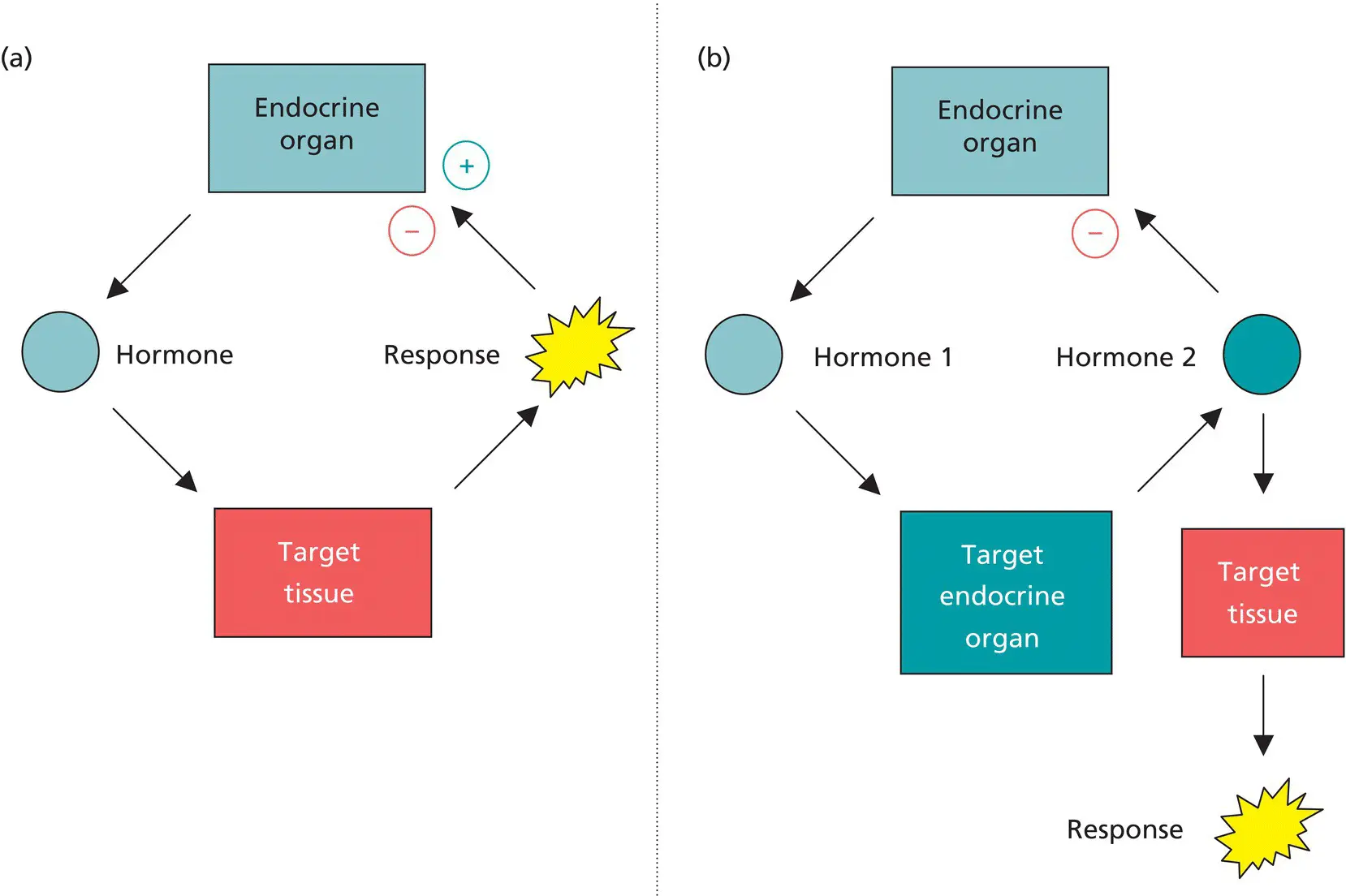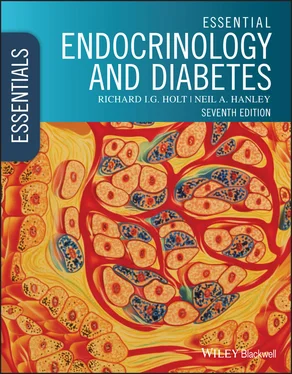1 ...6 7 8 10 11 12 ...24 
Figure 1.4 Control systems regulating hormone production and circulating levels. (a) The endocrine organ releases a hormone, which acts on the target tissue to stimulate a response. The response usually feeds back to inhibit () the endocrine organ and decrease further supply of the hormone. Occasionally, the feedback can act to enhance the hormone secretion (, positive feedback). (b) In this slightly more complex scenario, the endocrine organ produces hormone 1, which acts on a second endocrine gland to release hormone 2. In turn, hormone 2 acts dually on the target tissue to induce the response and feeds back negatively onto the original endocrine organ to inhibit further release of hormone 1. This model is illustrative of the axes between the anterior pituitary and the peripheral end‐organ targets.
Circadian = 24‐h cycle
Circa = about, dies = day
Ultradian < 24‐h cycle
E.g. GnRH release
Infradian > 24‐h cycle
E.g. menstrual cycle
The secretion of some hormones is under inhibitory as well as stimulatory control. Somatostatin, a hypothalamic hormone, prevents the secretion of GH so that when somatostatin secretion is diminished, GH secretion is enhanced. Prolactin is similarly controlled by tonic inhibition from dopamine.
Superimposed on the regulatory systems described above, many of the body’s activities show additional periodic or cyclical changes ( Box 1.5). Control of these rhythms commonly arises from the nervous system via the hypothalamus. Some appear independent of the environment, whereas others are coordinated and ‘entrained’ by external cues (e.g. the 24‐h light/dark cycle, which becomes temporarily disrupted in jetlag). Cortisol secretion is maximal between 0400h and 0800h as we awaken and minimal as we retire to bed. In contrast, GH and prolactin are secreted maximally ∼1 h after falling asleep. Clinically, this knowledge is important as investigation must be referenced according to hour‐by‐hour and day‐to‐day variability. Otherwise, such laboratory tests may be invalid or, indeed, misleading.
The chapters in Part 2 largely focus on organ‐specific endocrinology and associated endocrine disorders. Diabetes and obesity in Part 3 has now become its own specialized branch of endocrinology. Nevertheless, it is possible to regard all endocrine abnormalities as too much , too little or disordered production of hormone. Some clinical features occur because of compensatory overproduction of hormones. For example, Addison disease is a deficiency of cortisol from the adrenal cortex ( Chapter 6), which reduces negative feedback on ACTH production at the anterior pituitary. ACTH rises and stimulates melanocytes in the skin to increase pigmentation, especially in unusual locations, which is a striking sign of Addison disease.
Imbalanced hormone production may occur when a particular enzyme is missing because of a genetic defect. For example, in congenital adrenal hyperplasia, lack of 21‐hydroxylase prevents adequate cortisol synthesis ( Chapter 6). Other pathways within adrenocortical cells remain intact, leading to excess production of sex steroids that masculinize aspects of the female body. Endocrine disorders may also arise from abnormalities in hormone receptors or downstream signalling pathways. The commonest example is type 2 diabetes, which is characterized, at least in part, by resistance to insulin action in target tissues ( Chapter 13).
For endocrine organs under regulation by the hypothalamus and anterior pituitary, the associated disorders can also be categorized according to site. When disease is located in the end organ it is termed ‘primary’. When the end organ is affected because of an upstream problem in the anterior pituitary (either under‐activity or over‐activity) it is termed secondary, while in tertiary disease, the pathology resides in the hypothalamus.
Tumours affect all organs and tissues. In endocrinology, these tumours are most commonly sporadic and benign but they may over‐secrete hormones resulting in organ‐specific syndromes. These are described in the appropriate chapters of Part 2. Endocrine tumourigenesis may also affect multiple endocrine organs as unusual clinical syndromes. These are described in Chapter 10.
 Key points
Key points
Endocrinology is the study of hormones, defined classically by their secretion into the bloodstream
The endocrine and nervous systems are the body's two major communication systems
A hormone is a chemical messenger that elicits specific effects by binding to a receptor on or inside target cells
The three major types of hormones are peptides and the derivatives of amino acids or cholesterol
Negative and, occasionally, positive feedback, and cyclical mechanisms operate to regulate hormone production, commonly as part of complex multiorgan systems or axes
Clinical endocrine disorders usually reflect too much, too little or dysregulated hormone production
CHAPTER 2 Basic cell biology and hormone synthesis
Key topics
Chromosomes, mitosis and meiosis
Synthesizing a peptide or protein hormone
Synthesizing a hormone derived from amino acids or cholestero
Hormone transport
Key points
To appreciate the organization, structure and function of DNA
To understand mitosis and meiosis
To understand peptide or protein hormone production
To understand how enzyme cascades generate steroid and amino acid‐derived hormones
This chapter aims to introduce some of the basic principles that are needed to understand later chapters
This chapter introduces five major themes: chromosomes and DNA, the synthesis of the three different categories of hormone (peptide and proteins, and hormones derived from either amino acids or cholesterol), and hormone transport in the circulation. How hormones exert their actions is covered in Chapter 3.
The human genome is made up of deoxyribonucleic acid (DNA), assembled into 46 chromosomes in the nucleus ( Box 2.1). The DNA contains genes, which are the templates for synthesizing proteins. There are approximately 30,000 human genes that encode proteins. There are many thousands of other genes which are never translated into protein and play important regulatory roles, mostly within the nucleus. Each gene serves as the template for generating many copies of messenger ribonucleic acid (mRNA) by a process called transcription or gene expression. This transcription into mRNA is the means by which the information contained within a single gene becomes amplified and turned into many replica proteins. Specific proteins define the particular phenotype of a cell‐type (e.g. a thyroid cell that synthesizes thyroid hormone rather than the complement of proteins that, for instance, might lead to a beating cardiomyocyte). More commonplace proteins carry out basic functions such as the metabolic processes common to all cells. Proteins on the cell surface act as receptors that initiate intracellular signalling, which in turn is reliant on proteins that function as enzymes. Eventually, this signalling cascade reaches the nucleus and the proteins within it, called transcription factors. These latter proteins bind or release themselves from areas of DNA around genes to determine whether a gene is expressed (i.e. mRNA is transcribed) or silenced.
Читать дальше


 Key points
Key points










